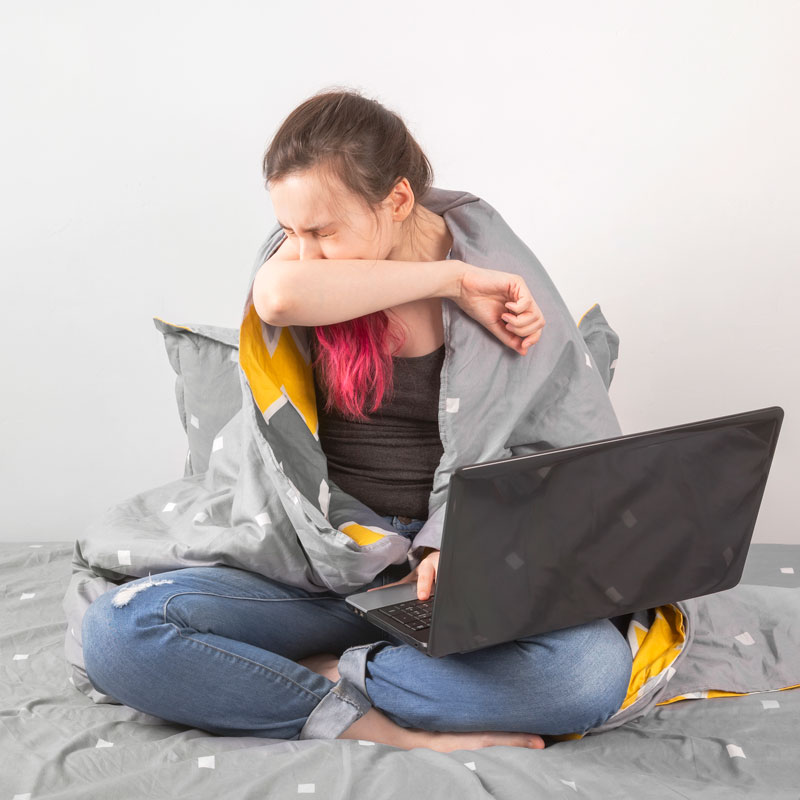
26 Jun Surface Contamination from Airborne Transmission Of COVID-19
The 2 metre social distancing rule dominates the prevailing legal and advisory guidance issued by governments world-wide. This rule is based on the well established research that assumes respiratory viruses are transmitted via contaminated droplets during exhalation, either as a normal process or more forcefully as coughs and sneezes. It is thought that respiratory diseases are transmitted by two routes: larger droplets (50+ microns) and much smaller aerosols (less than 5 to 10 microns). The prevailing assumptions are that the larger the droplets the shorter the distance it travels and the quicker the droplets fall on to surfaces. Therefore, the tiny aerosolised droplets that are ejected at high speed from coughing or sneezing will travel much further and stay aloft in the air for longer, and thus will more likely be inhaled in rather than settle on surfaces.
This two-route model is a rather over-simplification but potentially useful way to determine the likely surface contamination.
In real life, whenever we speak, we emit a ‘cloud’ containing a mix of all droplet sizes at a wide range of speeds, and this depends largely on how loud we are speaking. When we introduce involuntary reflexes like coughing and sneezing, the mix of droplet sizes is the same, but the ejected speeds are far higher, and in particular to coughing, the droplets come from deeper in the lungs. This means that it is highly likely that the tiny droplets travel much further than the 2 meter rule – some are known to travel 8 meters. The larger droplets still fall on to surfaces, but even they carry a higher speed and thus travel further.
What all this shows is that an arbitrary 2 meter distancing may not be suitable for all situations. In fact, dispersion of tiny aerosolised droplets is far more complicated, add into this mix the following factors:
- The varying amount of virial particles ejected from infected people at different stages of their illness. There is evidence that the viral shedding starts approximately 2 to 3 days before onset of symptoms.
- The number of viral particles in droplets (viral load) increase in line with the progression of the disease. There is evidence that the virus produces high viral load close to the onset of symptoms, leading to more likely pre-symptomatic spreading
- The number of infected people in a room or area – More people ejecting viral particles, the higher the density of contaminated droplets and therefore the more likely someone will inhale those droplets
- The duration of close contact (within 2 meters) with an infected person. The longer someone is in close contact with an infected person, the more likely they will inhale contaminated droplets.
- The air currents, air flow within a room or area and ventilation systems. When someone coughs the resulting ‘cloud’ of droplets will start to separate out: heavier droplets fall, and the lighter droplets remain in the air. If the air is static the droplets slowly spread out but hang in close proximity. If the air is moving because of natural or forced ventilation (HVAC systems), the droplets very quickly dilute in the air currents. By diluting the droplets, the likelihood of inhaling enough contaminated droplets to become infected drops off. Evidence of ventilation systems spreading viral particles in the air currents generated by these systems is limited.
However, we could make the following generalisations:
- It is likely that infected people, even with mild symptoms will eject high viral loads. This pushes the burden on to more proactive surface cleaning and disinfection
- Infected people who are actively and forcefully coughing or sneezing must be isolated in a room with plenty of fresh air
- The proximity and duration of contact with an infected person (or people) and not just the mere presence of an infected person (or people) should dictate the type of PPE to wear
- The physical distancing regimen alone is insufficient to reduce the risks. It must take into account other factors like air flow, air currents and the quality of the ventilation in place. PPE is then used to reduce the risks even further after all other factors have been considered.
Recommendations:
- All surfaces, including linen and clothes within 1 meter of an infected person (even with mild symptoms) will be contaminated by viral particles carried in large droplets. This distance increases as the severity of the symptoms increases.
- Warm temperatures and good ventilation will remove moisture in the droplets, both on surfaces and suspended in the air, and thereby reducing the risk of transmission
- Trace the likely path of someone who is infected or who has come in contact with someone infected and focus surface cleaning on those surfaces frequently touched or handled.
- All rooms that has been occupied by confirmed or highly suspected cases must be treated as isolation rooms. This means a full clean with a certified disinfectant after the room has been vacated. Adopt a Isolate-Seal-Control regime: isolate room, seal room to all nonessential personal and control exposure.
- Increase the frequency and ‘thoroughness’ of surface cleaning, prioritising all surfaces that are frequently handled by multiple people (hi-touch surfaces or contact points).
- No special or extra requirements are required for outdoor environments
Good References for further reading:
https://www.cebm.net/oxford-covid-19-evidence-service/
https://onlinelibrary.wiley.com/doi/full/10.1111/risa.13500
https://www.nejm.org/doi/full/10.1056/nejmc2004973
https://www.ecdc.europa.eu/en/covid-19/latest-evidence/transmission

